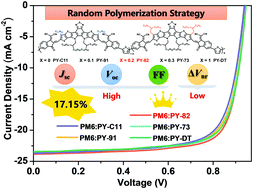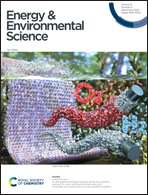An efficient polymer acceptor via a random polymerization strategy enables all-polymer solar cells with efficiency exceeding 17%†
Abstract
The past few years have witnessed rapid progress of all-polymer solar cells (all-PSCs), however, the simultaneous achievement of high open-circuit voltage (Voc), short-circuit current density (Jsc) and fill factor (FF) still remains a critical challenge. Herein, we used a random copolymerization strategy to develop a series of polymer acceptors named PY-X (where X stands for the molar ratio of two monomers) by polymerizing small molecule acceptor (SMA) monomers of SMA-C11 and SMA-DT with 2,5-bis(trimethylstannyl)thiophene as the connecting unit. Upon random copolymerization, the optical and electronic properties of the polymer acceptors can be well tuned. Consequently, compared with PY-C11 and PY-DT, the random copolymer based all-PSCs exhibit improved PCEs. The best-performing device based on PY-82 produces a high PCE of 17.15% (certified as 16.7%), with a Voc of 0.950 V, a Jsc of 23.82 mA cm−2, and an FF of 75.8%, representing the highest efficiency reported for the binary all-PSCs to date. This work suggests that random copolymerization is a promising synthetic strategy in developing efficient polymer acceptors.



 Please wait while we load your content...
Please wait while we load your content...